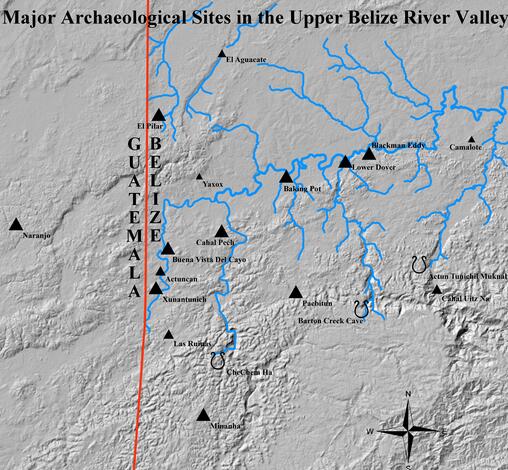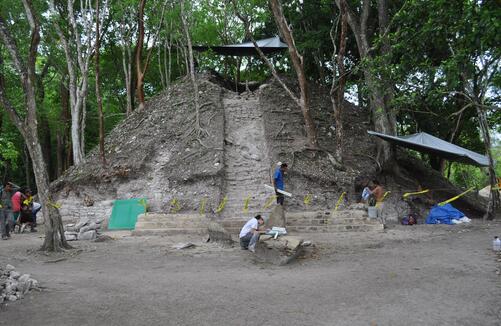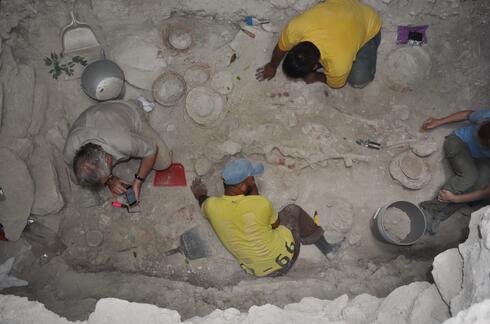The Discovery and Political Significance of the A9 Tomb and Hieroglyphic Panels 3 and 4 at Xunantunich, Belize
From:Shanghai Archaeology Forum NetWriter:Date:2017-12-12
The upper Belize River Valley, which is located along the border with Guatemala, contains some of the largest archaeological sites in the country of Belize. One of these ancient cities, known as Xunantunich, has been the focus of sporadic archaeological attention since the late 19th century. In spite of this long history of archaeological attention, however, few of the monumental buildings in the site’s epicentre had ever been systematically investigated. In an effort to address this omission, and to develop the site for its tourism potential, the Belize Government initiated a four-year program of excavation and conservation at Xunantunich between 2000 and 2004. The project, which was directed by Jaime Awe, successfully excavated and conserved six of the major structures in the site core. It also conserved a fragile stucco frieze on the large palace complex known as the Castillo, located fragments of three carved monuments, and discovered one of the first elite tombs at the site. Because of the success of the four-year project, Awe returned to the site in 2015 to begin another multi-year program of excavation and conservation. Known as the Xunantunich Archaeology and Conservation Project, this second project has two major goals. The first goal is to continue conserving the monumental architecture of the center in an effort to further develop the site for tourism purposes. The second goal is to acquire data that will further our understanding of the role of Xunantunich in the political landscape of the Late Classic period (650 – 850 A.D.) Belize River Valley.
During the 2015 field seasons, the project excavated and conserved a small shrine on the main acropolis and two temple pyramids on the eastern border of the site core. In 2016, excavations moved to the west side of the central courtyard, and began investigations on Structure A9. Like most of the buildings at Xunantunich, Structure A9 had received limited archaeological attention in the past. The first excavation on A9 was that conducted by British medical doctor and archaeological enthusiast Thomas Gann, who excavated a large crater at the summit of the mound in the late 1890s. A second excavation, by a UCLA project in the 1990s, focused on the south flank of the building. The latter excavation uncovered the basal terrace of the structure while the former discovered a simple burial just below surface at the summit of the building.
Our 2016 investigations focused on the eastern flank of Structure A9 and consisted of two large excavation units. The first excavation encompassed the entire eastern base of the mound. The second unit consisted of an axial trench that extended from the base to the summit of the building. Within the first three weeks of operation, our investigations made several significant discoveries. The finds included Hieroglyphic Panels 3 and 4, Burial A9-2, plus two caches or offerings that were discovered below the first step of the building’s central stairway, and below the base of an uncarved stela.

The caches contained a variety of local and exotic objects, including 36 obsidian and chert eccentrics. Burial A9-2 was enclosed in a large tomb, and contained the remains of a robust adult male who was about 40 years at the time of death. The burial was accompanied by 32 ceramic vessels, jade and shell jewellery, several obsidian blades, and a cache of jaguar and deer bones.
Our translation of the hieroglyphic inscriptions on Panel 4 noted that this monument contained a single major clause that started with the date 18 K’ank’in. Interestingly, this date, which corresponds to December 7 in AD 642, also occurs on a panel from a hieroglyphic stair that was discovered at the site of Naranjo in Guatemala. More significantly, however, the clause on our Panel 4 provides an articulate description of the dynastic re-establishment of the powerful Classic Period Snake-head dynasty from its original seat of power (at Dzibanche in present day Mexico) to the site of Calakmul, a process that was evidently thought to be completed by the lahuntun Period Ending of 9.10.10.0.0. (December 7, ad 642).

The inscriptions on Panel 3 provided us with three statements. The first was a death statement for Lady Batz’ Ek who died in 638 AD. Inscriptions at the site of Caracol, located about 50 kilometers south of Xunantunich, identify Lady Batz’ Ek as the mother of Lord Kan II, a prominent ruler of that site’s royal lineage. The second statement on Panel 3 includes another death statement for Waxaklajuun Ubaah Kan, a ruler of the Kaanul or Snake Dynasty who died in 640 AD. The third statement referred to a ball game.
Prior to the discovery of the Xunantunich panels, the transfer of the Snake Dynasty from its original seat of power at Dzibanche to Calakmul had only been conjectured by epigraphers. Concrete proof for this change, however, had previously never been recovered. Our panels also made it clear that the transfer of power from one polity to the other was the result of a “civil war” between two factions of the Snake Dynasty. The Dzibanche faction under the leadership of Waxaklajuun Ubaah Kan lost that war, he was taken captive, and subsequently sacrificed by his dynastic relative at Calakmul.
With the establishment of its seat of power at the city of Calakmul, the Kaanul or Snake Dynasty eventually became one of the most powerful kingdoms of the Classic period Maya world. From about 562 AD, to almost the end of the 7th century, the kings of the Snake Dynasty established strategic alliances that enabled them to defeat and subjugate their major regional competitors in the Maya lowlands. These successes also allowed them to exact tribute from the defeated polities, and to establish Calakmul as one of the largest and most dominant city states in the Maya world.

But what does all this have to do with Xunantunich? Shortly after their discovery, we had begun to question the origin of the hieroglyphic panels because neither the style of execution or the palaeography of the inscriptions were similar to the style rendered on other carved monuments at Xunantunich. The same was true of the dense limestone used to produce the panels. As our geologist confirmed, the raw material used for the production of Panels 3 and 4 was more typical of the limestone used to produce the carved monuments at Caracol, a large center about 50 kilometres due south in the Maya Mountains of Belize. Analysis of the inscriptions by our project epigrapher also indicated that the two panels were actually part of a hieroglyphic stairway that had been discovered at Naranjo, another large center located 14 kilometres to the west in Guatemala.
The Naranjo hieroglyphic stair was first documented at the Guatemalan site of Naranjo by Austrian explorer Teobert Maler in 1905. In a subsequent visit to the site in 1909, epigrapher Sylvanus G. Morley recorded the calendrical information carved on the stair. In yet another visit to Naranjo in the 1970s, British epigrapher Ian Graham illustrated and recorded the entire hieroglyphic data carved on the monuments. Graham’s in situ documentation of the hieroglyphic stair remains the primary source of information on the Naranjo Hieroglyphic Stair because all but one fragment of the stair was subsequently looted from the site and sold in the antiquities market.
A subsequent (1980s) analyses of Graham’s photographs and drawings by Linda Schele resulted with several very interesting observations. The study revealed that the inscribed sections, or blocks, of the stair were out of syntax, that the stair was missing some fragments, and that the blocks had been set in an illegible order. Even more interesting was that, in spite of the scrambled order of the glyph blocks, the inscriptions indicated that the stair had been commissioned by Lord Kan II, ruler of Caracol, to record his defeat of Naranjo in 631 AD. Schele and David Freidel also argued that Lord Kan II purposely erected the hieroglyphic stair in the capital of his defeated enemy in an apparent effort to add “insult to injury.” This conclusion, however, bothered later epigraphers for it failed to explain why the inscribed blocks of the stair were placed out of syntax and order. This inconsistency eventually led Simon Martin and Nikolai Grube to offer an alternative hypothesis in 2004. Martin and Grube proposed that the hieroglyphic stair was originally erected by Kan II at his own capital of Caracol in 631 AD. Forty-nine years later, in 680 AD, K’ahk’ Xiiw Chan Chaahk of Naranjo avenged his city by attacking and defeating Caracol, and then dismantled and transported most of the fragments of the hieroglyphic stair to his Naranjo. These fragments were subsequently mounted on the building where they were discovered at Naranjo, but purposely reassembled out of order to make them illegible (or out of syntax).

When we put all these seemingly, disjointed pieces of information together in a cohesive manner, the following picture began to emerge. It was apparent that following his defeat of Naranjo in 631 AD, Lord Kan II commissioned the carving and construction of a hieroglyphic stair that was erected at his capital city of Caracol. The date on Panel 4 indicates that the stair was completed and erected in 642 AD. Besides describing his defeat of Naranjo, inscriptions on the stair blocks also mentioned the death of Lord Kan’s mother Lady Batz’ Ek’, the death of Waxaklajuun Ubaah Kan of the Snake Dynasty, and the transferal of the Snake Dynasty’s seat of power to Calakmul. The reason why Kan II makes reference to these events on the hieroglyphic stair was because he was an ally of the Calakmul’s branch of the Snake Dynasty, and because his mother was likely affiliated with that dynasty, coming to Caracol as part of a marriage alliance. In 680 AD, 49 years after their defeat by Kan II, the ruler of Naranjo exacted revenge on Caracol. Besides defeating the latter, the Naranjo ruler dismantled the hieroglyphic stair at Caracol, then moved most of the blocks to Naranjo where they were reassembled out of order so as to make them illegible.
While the latter information certainly allowed us to contextualize the hieroglyphic inscriptions of Panels 3 and 4 at Xunantunich, and while it also helped us to determine the origins of the two monuments, two major questions still remained unanswered. That is, how did two fragments of the so-called Naranjo Hieroglyphic Stair make their way to Xunantunich, and why were they placed on the flanks of Structure A9? One potential, but hypothetical, answer was that the elite interred in Burial A9-2 was somehow associated with the events that resulted in the dismantling and removal of the stairs from its original location at Caracol. Inscriptions at both Naranjo and Xunantunich indicated that the two sites were close allies during the 7th and 8th centuries. We therefore hypothesized that if the individual in Burial A9 participated in the defeat of Caracol in 680 AD, that the panels were likely his share of the war booty. This could also explain why the two panels were eventually erected on the flanks of the stairway of his funerary temple. To validate this hypothesis, however, the individual in Burial A9-2 would have had to be alive and of mature age during the battle between Naranjo and Caracol in 680 AD. In an effort to test this possibility, we submitted fragments of human and animal bone from the tomb for AMS 14C dating. The date on the human remains came back at 660 – 775 calibrated AD, and the date on the deer bone was 690 – 890 AD. Although both had a spread of about 100 years, both dates nevertheless confirmed that the individual in the tomb could have certainly been alive and old enough to participate in the battle between Naranjo and Caracol. Period ending dates on two ceramic vessels found in the tomb provided additional confirmation for this possibility. One of the tomb vessels had a period ending date of 10 Ajaw or 672 AD, and the other had a date of 8 Ajaw or 692 AD. Again, both of these dates overlap with the date of the war event, and provide additional support for the hypothesis that the individual in Tomb A9-2 likely participated in the war as an ally of Naranjo.
Prior to our investigations at Xunantunich, previous researchers at the site had noted that the site did not rise to prominence until sometime around the 7th to 8th centuries. They surmised that Xunantunich’s rapid growth around this time corresponded with a shift in the polity’s political organization, from an autonomous political center to a polity subordinate to Naranjo. The also suggested that Xunantunich was either a dependent ally or a directly ruled, annexed province of Naranjo, and that the site’s rulers could have either been members of a local elite family elevated to this new position of authority, or they could have been outsiders inserted into the valley’s political landscape. To determine whether the individual in Tomb A9-2 was local or foreign, we decided to conduct strontium isotope analysis on the human remains. Previous research in the region had established that the mean strontium values for Belize River Valley sites was about 0.7086 with a range of 0.7082 to 0.709. Results of our analysis on the Structure A9 individual yielded a value of 0.708386. This strontium value fits the Belize River Valley signatures very well, suggesting that the elite buried in the tomb was local, and thus not inserted into the Xunantunich political landscape by Naranjo.
In conclusion, our investigations at Xunantunich exemplifies the value of applying multi-disciplinary scientific analysis to the study of the archaeological record. It further demonstrates the value of conducting meticulous excavation techniques, the application of strontium isotope analysis on ancient human remains, zooarchaeological analysis of animal remains, artifact analysis of grave goods, radiometric dating of human and other organic remains, and the decipherment of ancient Maya hieroglyphic writing. It is only through the application of this type of holistic approach that we can now begin to unravel many of the secrets of the past, while at the same time contributing to the development of the archaeological resources of the country of Belize.

